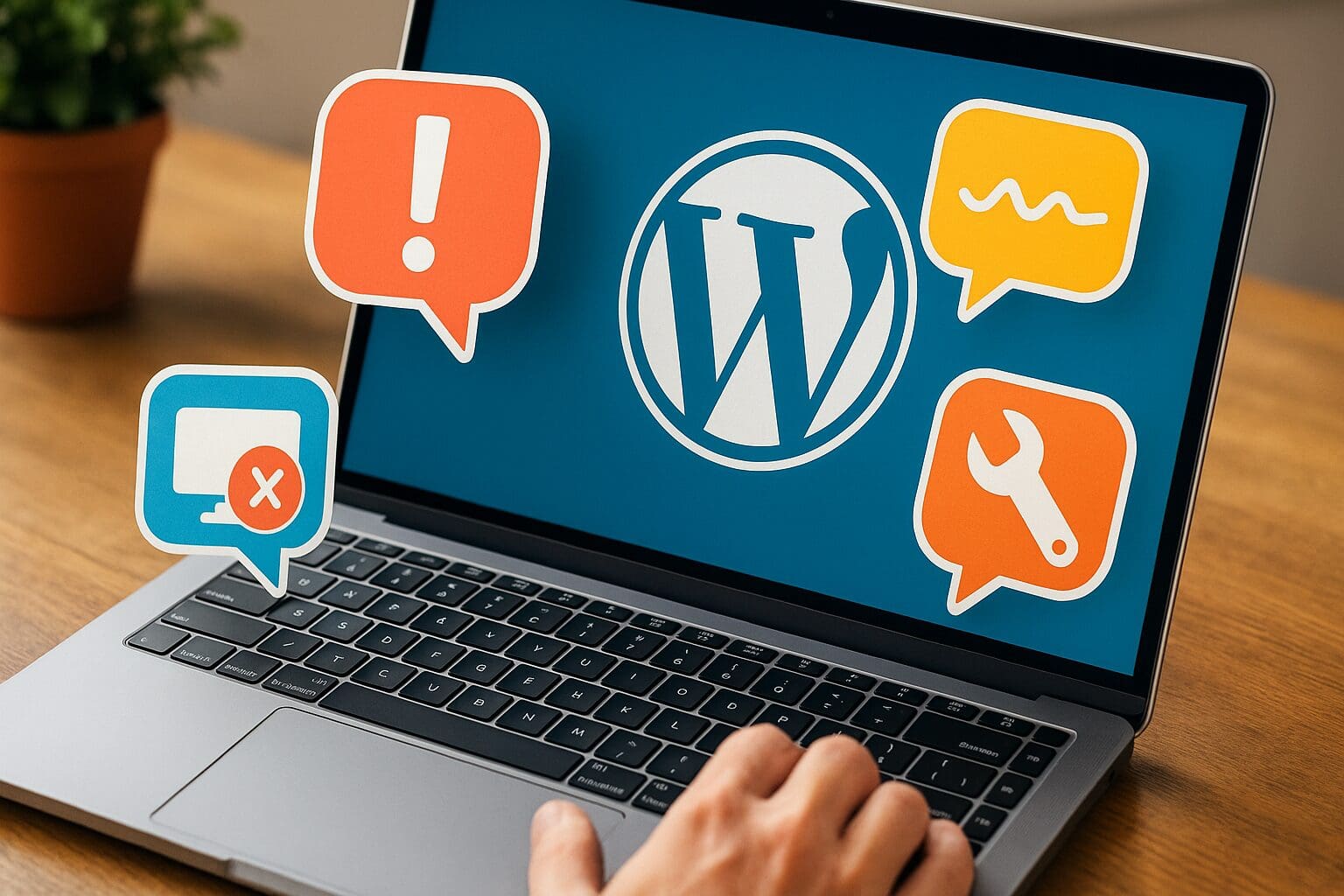
Quick Fixes for WordPress Errors: The Complete Troubleshooting Guide
Quick Fixes for WordPress Errors: The Complete Troubleshooting Guide
Why You’re Here
If your WordPress website suddenly shows a blank screen, a “database connection error,” or other unexpected failures—don’t panic. These are common WordPress issues that can often be resolved in minutes, without a developer.
In this guide, you’ll learn how to identify and fix the most frequent WordPress problems with simple, proven steps.
🔧 1. White Screen of Death (WSoD)
Symptoms: A blank white screen when accessing your site or admin panel.
Common Causes:
- Faulty plugins or themes
- PHP memory limit reached
How to Fix It:
- Use FTP to access
/wp-content/pluginsand rename plugin folders to disable them. - Switch to a default theme like Twenty Twenty-Four.
- Increase memory in
wp-config.php:define('WP_MEMORY_LIMIT', '256M'); - Enable debug mode to identify the error:
define('WP_DEBUG', true);
🔒 2. 500 Internal Server Error
Symptoms: A generic 500 error message without details.
Possible Causes:
- Corrupted
.htaccessfile - Incompatible themes or plugins
- Low PHP memory
Fix It Step-by-Step:
- Rename or delete the
.htaccessfile via FTP. - Go to Settings → Permalinks in WordPress and click “Save Changes” to regenerate it.
- Deactivate plugins/themes one by one to identify the culprit.
- Review server logs via your hosting panel for more insight.
🔗 3. Error Establishing a Database Connection
Symptoms: WordPress can’t connect to the database.
Likely Causes:
- Incorrect credentials in
wp-config.php - Wrong database host
- MySQL server down or overloaded
Quick Solution:
- Check the following lines in your config file:
DB_NAME DB_USER DB_PASSWORD DB_HOST - Confirm correct host (often “localhost”).
- If needed, restart MySQL or free up server resources.
4. 404 Errors After Changing Permalinks
Symptoms: Page or post URLs lead to “Page Not Found”.
Causes:
- Outdated permalink settings or
.htaccessfile
Solution:
- Navigate to Settings → Permalinks, click “Save Changes” (even without edits).
- Delete and regenerate the
.htaccessfile if necessary.
5. Login Issues or Redirect Loops
Symptoms: Login form reloads, or endless redirect loops.
Typical Causes:
- Browser cookies or cache
- Mixed use of www/non-www URLs
- Security plugin interference
Fix It:
- Clear browser cache and cookies.
- Use phpMyAdmin to check and correct
siteurlandhomein thewp_optionstable. - Disable plugins via FTP if login remains blocked.
6. Plugin and Theme Conflicts
Symptoms: Errors occur right after activating a plugin or theme.
What’s Behind It:
- Outdated, poorly coded, or incompatible add-ons
Resolution:
- Deactivate all plugins, then reactivate them one at a time.
- Temporarily switch to a default WordPress theme for testing.
- Update or replace problematic plugins/themes.
🚀 7. Outdated PHP Version
Symptoms: Incompatibilities, error messages, slow performance.
Why It Happens:
WordPress and plugins need PHP 8.0+ to run properly.
What to Do:
- Upgrade PHP from your hosting control panel.
- Test your site after upgrading.
- Switch hosting provider if PHP versions are limited.
🛠 8. Enable Debug Mode
When to Use: When the site is blank or returns vague errors.
How to Enable:
Add the following to wp-config.php:
define('WP_DEBUG', true);
Don’t Forget: Turn it off once you’re done troubleshooting:
define('WP_DEBUG', false);
🔐 9. SSL/HTTPS Issues and Mixed Content Warnings
Symptoms: Browser warnings like “Not secure” or broken padlocks.
Causes:
- Missing or expired SSL certificate
- Mixed HTTP and HTTPS content
Solution:
- Enable SSL (Let’s Encrypt or similar) via your host.
- Use Really Simple SSL plugin to force HTTPS redirects.
- Use Better Search Replace to update all old HTTP URLs in your database.
🔄 10. Migration or Domain Change Errors
Symptoms: 404s, broken design, missing media.
What Went Wrong:
- Hardcoded URLs, unupdated database entries, or permalinks not reset
Fix It:
- Use tools like Duplicator or All-in-One WP Migration
- Resave permalinks
- Check database values for
siteurlandhome - Update links, menus, widgets as needed
💻 11. WP‑CLI for Advanced Recovery
What It Is: Command-line tool for managing WordPress installations.
Powerful Commands:
wp plugin deactivate --all
wp theme list
wp db repair
Use
define('WP_ALLOW_REPAIR', true);in your config to enable database repair.
⏱️ 12. Failed Cron Jobs
Symptoms: Missed scheduled posts, broken plugin tasks.
Why It Happens:
- Internal WordPress cron is disabled or misfiring
Fix It:
- Set
DISABLE_WP_CRONtofalseinwp-config.php - Set up a real system cron job for high-traffic sites
⚠️ 13. Automatic Updates Causing Conflicts
Pros: Better security
Cons: Potential plugin/theme incompatibility
Best Practices:
- Allow only minor updates automatically
- Run full backups before major version upgrades
- Test in a staging environment
🛡️ 14. Security Plugin Lockouts
Problem: Security plugins block legitimate access or trigger false alarms.
How to Fix It:
- Rename the security plugin folder via FTP to deactivate it
- Review firewall/IP settings once you regain access
- Avoid overly aggressive options like login obfuscation or IP bans unless truly necessary
✅ Final Tips to Keep WordPress Error-Free
- Keep core, plugins, and themes updated
- Backup regularly
- Use a staging site for tests
- Choose reliable, WordPress-optimized hosting
- Monitor your PHP version and adjust when needed
With this guide, you’ll always be ready to handle the most common problems in minutes, calmly and expertly.

![Vultr_logo_high_res[1] Vultr_logo_high_res[1]](https://b3400949.smushcdn.com/3400949/wp-content/uploads/elementor/thumbs/Vultr_logo_high_res1-qy0twclne9rg9ku0ilspwh1zqace3ki9i98m9n6680.png?lossy=2&strip=1&webp=1)

